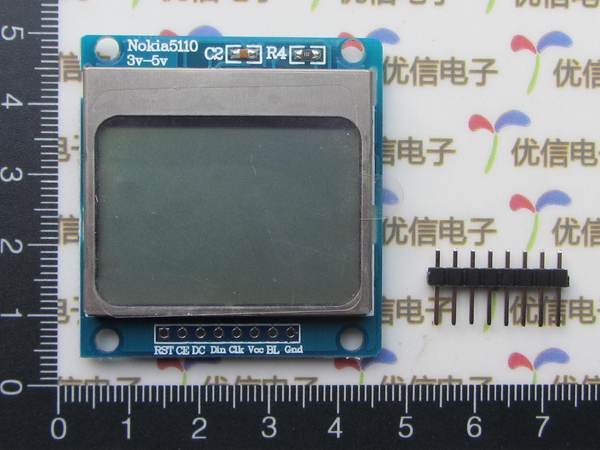升级版电子钟 - 如何使用Raspberry Pi驱动Nokia 5110液晶屏
目录:
Nokia 5110屏比前面介绍过的1602液晶屏功能好很多,淘宝上买价格相差不大(二手5110 12块左右, 全新1602 8块左右),Nokia 5110最少只需要占用4个GPIO引脚:
- 带蓝色背光
- 使用Philips PCD8544 LCD控制器(通过SPI接口)
- 84x48点阵,可显示100多个字符
硬件准备
- 树莓派
- Nokia 5110 拆机屏 或 焊好的? 注意不要买裸屏,需要带电路板的
- 杜邦线 母对母8条
- 8P排针 用来焊接5110屏幕PCB板
- 电烙铁
电路
5110电路板有8个引脚,使用排针(如下图)将其焊上,方便后面用杜邦线连接,如果不会焊也可以买焊接好的。

- RST —— 复位 接GPIO 0
- CE —— 片选 接GPIO 1 或 不接
- DC —— 数据/指令选择 接GPIO 2
- DIN —— 串行数据线 接GPIO 3
- CLK —— 串行时钟线 接GPIO 5 (因为我的GPIO 4已经接了一个DHT11传感器)
- VCC —— 电源输入 接3.3v
- BL —— 背光控制端 接3.3v
- GND —— 地线 接地
PS. 编号规范看这里 VCC, BK, GND可以接在面包板电源上
代码
显示字符
需要安装RPi.GPIO库
#!/usr/bin/python
# -*- coding: utf-8 -*-
import RPi.GPIO as GPIO
import time
import sys
#gpio's :
SCLK = 18
DIN = 15
DC = 13
RST = 11
font =[
0x7E, 0x11, 0x11, 0x11, 0x7E, # A
0x7F, 0x49, 0x49, 0x49, 0x36, # B
0x3E, 0x41, 0x41, 0x41, 0x22, # C
0x7F, 0x41, 0x41, 0x22, 0x1C, # D
0x7F, 0x49, 0x49, 0x49, 0x41, # E
0x7F, 0x09, 0x09, 0x09, 0x01, # F
0x3E, 0x41, 0x49, 0x49, 0x7A, # G
0x7F, 0x08, 0x08, 0x08, 0x7F, # H
0x00, 0x41, 0x7F, 0x41, 0x00, # I
0x20, 0x40, 0x41, 0x3F, 0x01, # J
0x7F, 0x08, 0x14, 0x22, 0x41, # K
0x7F, 0x40, 0x40, 0x40, 0x40, # L
0x7F, 0x02, 0x0C, 0x02, 0x7F, # M
0x7F, 0x04, 0x08, 0x10, 0x7F, # N
0x3E, 0x41, 0x41, 0x41, 0x3E, # O
0x7F, 0x09, 0x09, 0x09, 0x06, # P
0x3E, 0x41, 0x51, 0x21, 0x5E, # Q
0x7F, 0x09, 0x19, 0x29, 0x46, # R
0x46, 0x49, 0x49, 0x49, 0x31, # S
0x01, 0x01, 0x7F, 0x01, 0x01, # T
0x3F, 0x40, 0x40, 0x40, 0x3F, # U
0x1F, 0x20, 0x40, 0x20, 0x1F, # V
0x3F, 0x40, 0x38, 0x40, 0x3F, # W
0x63, 0x14, 0x08, 0x14, 0x63, # X
0x07, 0x08, 0x70, 0x08, 0x07, # Y
0x61, 0x51, 0x49, 0x45, 0x43, # Z
]
def main():
begin(0xbc) # contrast - may need tweaking for each display
gotoxy(28,0)
text("HELLO")
gotoxy(8,2)
text("RASPBERRY PI")
gotoxy(6,2)
text("Hugo")
def gotoxy(x,y):
lcd_cmd(x+128)
lcd_cmd(y+64)
def text(words):
for i in range(len(words)):
# print (words[i])
display_char(words[i])
def display_char(char):
index=(ord(char)-65)*5
if ord(char) >=65 and ord(char) <=90:
for i in range(5):
# print (index+i)
lcd_data(font[index+i])
lcd_data(0) # space inbetween characters
elif ord(char)==32:
lcd_data(0)
lcd_data(0)
lcd_data(0)
lcd_data(0)
lcd_data(0)
lcd_data(0)
def cls():
gotoxy(0,0)
for i in range(84):
for j in range(6):
lcd_data(0)
def setup():
# set pin directions
GPIO.setmode(GPIO.BOARD)
GPIO.setup(DIN, GPIO.OUT)
GPIO.setup(SCLK, GPIO.OUT)
GPIO.setup(DC, GPIO.OUT)
GPIO.setup(RST, GPIO.OUT)
def begin(contrast):
setup()
# toggle RST low to reset
GPIO.output(RST, False)
time.sleep(0.100)
GPIO.output(RST, True)
lcd_cmd(0x21) # extended mode
lcd_cmd(0x14) # bias
lcd_cmd(contrast) # vop
lcd_cmd(0x20) # basic mode
lcd_cmd(0xc) # non-inverted display
cls()
def SPI(c):
# data = DIN
# clock = SCLK
# MSB first
# value = c
for i in xrange(8):
GPIO.output(DIN, (c & (1 << (7-i))) > 0)
GPIO.output(SCLK, True)
GPIO.output(SCLK, False)
def lcd_cmd(c):
# print ("lcd_cmd sent :",hex(c))
GPIO.output(DC, False)
SPI(c)
def lcd_data(c):
# print ("data sent :",hex(c))
GPIO.output(DC, True)
SPI(c)
if __name__ == "__main__":
main()
显示图形-树莓派Logo
#include <wiringPi.h>
#include <stdio.h>
#include <stdlib.h>
#include "PCD8544.h"
// pin setup
int _din = 3;
int _sclk = 5;
int _dc = 2;
int _rst = 0;
int _cs = 1;
// lcd contrast
int contrast = 50;
int main(int argc, char* argv[])
{
// print infos
printf("Raspberry Pi PCD8544 test\n");
printf("========================================\n");
printf("CLK on Port %i \n", _sclk);
printf("DIN on Port %i \n", _din);
printf("DC on Port %i \n", _dc);
printf("CS on Port %i \n", _cs);
printf("RST on Port %i \n", _rst);
printf("========================================\n");
// check wiringPi setup
if (wiringPiSetup() == -1)
{
printf("wiringPi-Error\n");
exit(1);
}
// init and clear lcd
LCDInit(_sclk, _din, _dc, _cs, _rst, contrast);
LCDclear();
// turn all the pixels on (a handy test)
printf("Test: All pixels on.\n");
LCDcommand(PCD8544_DISPLAYCONTROL | PCD8544_DISPLAYALLON);
delay(1000);
// back to normal
printf("Test: All pixels off.\n");
LCDcommand(PCD8544_DISPLAYCONTROL | PCD8544_DISPLAYNORMAL);
LCDclear();
// display logo
printf("Test: Display logo.\n");
LCDshowLogo();
delay(2000);
LCDclear();
}
安装效果

参考链接
blog comments powered by Disqus

